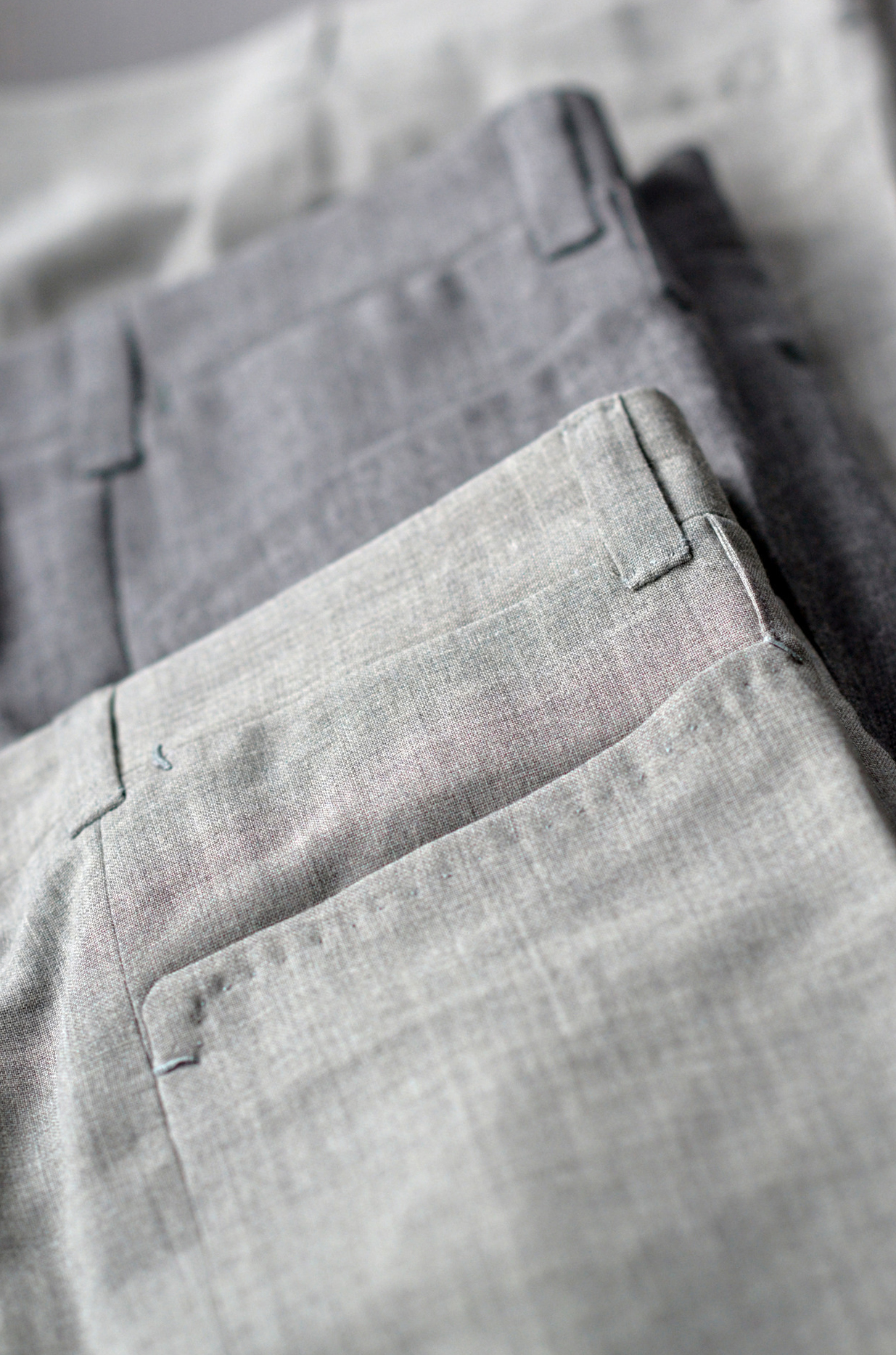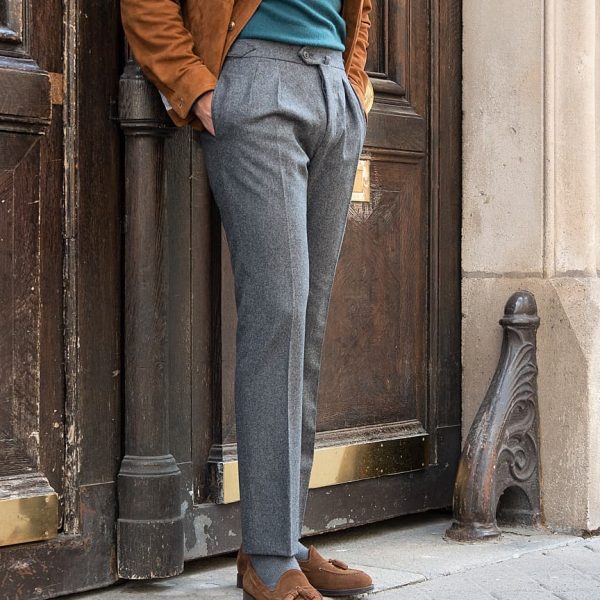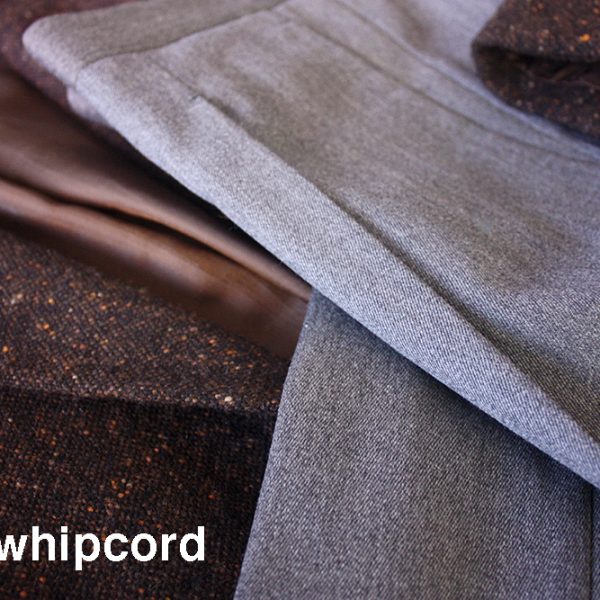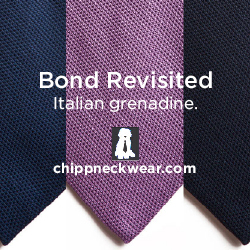
If you were to shop for a pair of trousers today, you would be buried in options. Over at Mr. Porter, you can find nearly 850 models, ranging from silk-linen-wool blends to faint glen plaids retailing for over $2,000. More affordably, J. Crew’s stretch-cotton chinos can be had for less than $80, and they come in colors that sound like Kelly-Moore paints, such as “river brown” (which is tan) and “dark eucalyptus” (which is green). Even at classic clothiers such as O’Connell’s, you have to choose from an endless number of materials, including Super 100 worsteds, moleskins, seersucker, cotton drill, and gabardine.
In a world full of trouser options, it’s easy to get lost and not know what to wear. One of the most common questions on menswear boards and forums is: “what goes with this sport coat I’m considering?” As you build out a wardrobe, it can be fun to experiment with patterns, colors, and materials. But if you’re just starting out, it’s better to stick to some simple rules: grey and tan are your most useful colors, solid colors are easier to wear than patterns, and you can switch things up by varying the weave.

The Importance of Weave
In terms of classic men’s dress, the focus of an outfit is typically the v-shaped intersection that forms between the jacket, shirt, and tie. This is why trousers are easier to wear when they’re grey, and shoes are easier to wear when they’re dark brown or black. These are the default colors for such items, so they play in the visual background of an outfit.
This doesn’t mean that you have to wear the same grey pants in every outfit. In the photo above, Alan See of The Armoury shows how grey pants can look very different depending on the weave. Broadly speaking, fabrics come in two weaves: plain and twill. Plain weaves have some variation of a tic-tac-toe pattern, where the yarns criss-cross each other like the mesh on a screen door. On the other hand, twills have diagonally running ribs, such as you see on your jeans. And again, broadly speaking, plain weaves are typically more breathable than twills, but twills are generally harder wearing.
In the photo above, you can see a vintage 160s cavalry twill set on top of various plain weaves: a Minnis Fresco, a Dugdale New Fine Worsted, and a Spence Bryson tropical linen. Depending on the fiber and weave, a pair of trousers can have different textures, which in turn lends different looks. This may seem very subtle on screen, but it genuinely makes a difference in real life.

Grey Flannels
If you’re just starting to build a wardrobe, start with two or three pairs of classic grey flannels. Today, the term flannel is commonly associated with plaid cotton shirts. But in the tailored clothing world, it refers to a soft wool material with a bit of nap. Some say the term is derived from the Welsh word gwalen, which means something made from wool. Around 1930, flannel was worn for summer trousers, including for sports such as tennis. In modern times, it’s the default trouser material for nearly any sport coat except linen. Grey flannels can be worn with navy blazers, brown corduroy sport coats, wool-silk-linen jackets, and tweeds in any earthy color. They are a genuine staple in any tailored wardrobe.
There are actually two types of flannel: worsted and woolen. These terms should probably be renamed combed and uncombed because it’s the combing process that separates them. Before the fabrics are woven, the yarns must be spun. And before the yarns are spun, a spinner can separate out the fibers by combing the material. This sets the hairs parallel to each other and removes any of the shorter fibers that would spoil the regularity characteristic of worsted. After the wool has been combed, it’s spun into yarn and then woven into a fabric. And by combing the hairs first, the resulting material will feel a bit smoother and crisper, which is how you get shiny, hard-finished fabrics. Woolens, on the other hand, aren’t put through the same process. Thus, the fabric is spongier and loftier, as the fibers point in every possible direction. To give examples, gabardine is worsted; tweeds are generally woolen.
Worsted flannels will still have a bit of a nap, but they’re generally smoother and more uniform than their woolen counterparts. If you’re wearing flannel in the summer, go for a worsted flannel because it can be made in lighter weights. For winter, a heavier woolen will keep you warmer. You will also want these in three different shades, such as you see above: pearl grey, mid-grey, and a slightly darker grey. Be careful of charcoal, which can be too close to black and thus hard to wear.

Grey Tropical Wools
Once you have some grey flannels, get the same colors in tropical wool. Online, this material is sometimes referred to as Fresco, but Fresco is just a branded name for a type of tropical wool, much like how Kleenex is a type of facial tissue and Coke is a type of fizzy drink. Tropical wools are named so because they perform well in hot and humid climates, such as you would find in the tropics. Tropical wool is more breathable, and since the fibers spring back readily, they’re ideal for traveling.
For temperate climates that mostly hover around the 60s and 70s, you may be able to get away with just grey flannels in different weights. But if you live in an area with real summers, then you’ll need some grey tropical wools. They can be worn with similarly open weave sport coats, such as Mock Leno with lighter weight canvasses and partial lining. Again, get these in various shades of grey, but not as dark as charcoal. I find that mid-grey works best, although it’s nice to have slightly lighter and darker colored options depending on the jackets in your wardrobe.

The Very Useful Twill
Those with a bit of experience with tailored clothing will likely already have grey flannels and tropical wools in their closet. In which case, I suggest adding some twills. Twills are harder wearing and can add visual interest to an outfit. They also tend to drape better, as the weave hangs like iron and swings when you walk. In the photos above, you can see how these different materials look when worn or when they’re set next to each other.


The Best Twills: Cavalry and Whipcord
Let’s start with your two most useful twills: cavalry and whipcord. Cavalry twills were originally used for riding pants, which is how they got their name. Whipcord fabrics were traditionally reserved for the outermost layer on hunting clothes, as their tight weave resisted snagging from stray bramble and branches. Today, both go naturally with rustic garments, such as Shetland sweaters, tweed sport coats, and waxed cotton Barbours. They can be worn any time in the autumn and winter months when you’d wear grey flannel trousers.
You can tell these two materials apart by their weaves. Cavalry twill has a double twill, such that you see a twill within a twill. Whipcord, on the other hand, is a normal twill, like you see on your jeans, although it’s often a little more mottled. In the photos above, cavalry twill is the greyish color on the left; whipcord is the green fabric on the right.
The first photo above is from Last & Lapel’s Instagram. Their post has the trousers labeled as cavalry twill, but the material is, in fact, whipcord (online, these two fabrics are commonly mixed up because you have to inspect the twill closely). Either way, their photo nicely illustrates how wonderful a good twill can look when made into trousers. In a solid color and neutral shade (e.g., khaki, beige, taupe, or grey), these can add visual interest to an outfit without being obtrusive. They’re not as loud as patterned pants, but they’re more interesting, sporty, and casual than Super 100 worsteds. I wear mine with navy sport coats, earthy tweeds, brown corduroy jackets, and basically any time when a tight weave and heavy fabric isn’t too uncomfortable because of the weather.

Here, again, you can see what different weaves can do for an outfit. Granted, the differences are relatively subtle when compared to casualwear, but that’s the game in classic tailored clothing, where parameters are more tightly defined, and differences often come down to minute details. Still, in the photos above, you can see how a navy sport coat can look when put up against grey flannels versus grey whipcords. Tweeds do exceptionally well with cavalry twill and whipcord, particularly in earthy colors such as tan. Don’t be afraid of going too big with the rib, either. From just a few feet away, a larger, more well-defined rib will only help a sport coat outfit look sportier. In the summer months, you can also reach for sharkskin trousers, which are more breathable than whipcords but offer more texture than tropical wools.
Note, there is a trade-off. Twills are often what those in the tailoring industry call “hard finished,” which means they don’t have the nap you find on soft woolens. They’re generally harder wearing, but they can develop a bit of a shine as they wear down. Whereas woolen trousers will eventually go threadbare and then just wear through, a hard finished twill will get shinier in areas that get the most pressure (e.g., your seat). On the other hand, twills are less prone to bagging. A slim pair of flannels will sometimes bag at the knees, lose their crease, and just generally need a bit of touching up and re-pressing every so often, whereas twills hold their shape better over time.
As for where to find good trousers, our sponsor Dapper Classics offers some of the best values we’ve seen online. Their pants are made at the Hertling trouser factory in Brooklyn, New York. Since they don’t have to pay for import duties and taxes, they’re able to sell a wonderfully tailored, classically cut trouser for about $200-250. For something higher-end, you can try The Armoury or Rota. Their trousers are generally made with generous inlays, which allows for greater flexibility when you’re doing alterations (I find that most men benefit from shortening the back rise and dropping the crotch seam, which improves the drape at the back of their trousers). If you’re in San Francisco, Tailor’s Keep makes exceptional bespoke pants at a fraction of what many Savile Row tailoring houses charge. Those in New York City can wait for Pommella’s bespoke tailoring trunk shows at The Armoury.
Other reliable trouser options include Epaulet, H. Stockton, O’Connell’s, Spier & Mackay, Junior’s, Last & Lapel, and our other sponsor Proper Cloth. Mauro at Wolf vs. Goat tells me that he’s about to launch a new trouser line made in Italy from Vitale Barberis Canonico wools, which will retail for between $150 to $200, depending on the fabric. Some of the photos above are also from Scavini, a made-to-order company based in Paris. I found them through Instagram, but have no experience with their products (the trousers look a bit slim, but I like that they offer a wide range of materials, including the hard-to-find whipcord). Finally, Dylan & Son, a bespoke workshop based in Singapore, is launching a remote custom-tailoring service. I again don’t have any experience with their tailoring, but I’ve been impressed with what the head trouser cutter, Dylan Chong, has shown online.
For a very basic trouser wardrobe, I’d start with two pair of grey flannels in varying shades, two pairs of grey or tan tropical wools, a tan pair of cavalry twills, a taupe pair of whipcords, and then either a pair of grey shakskins or grey whipcords depending on the climate in your region.



















